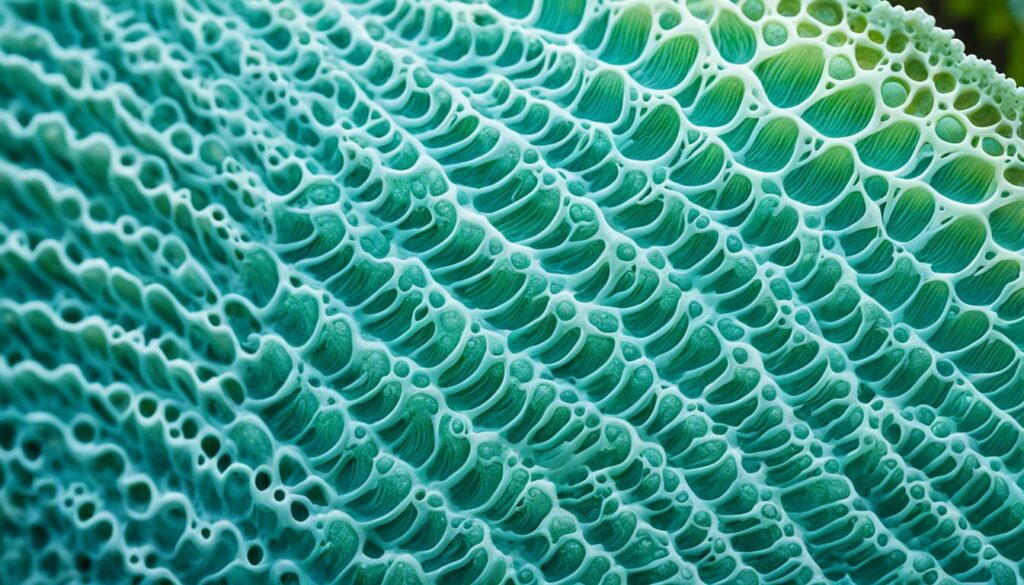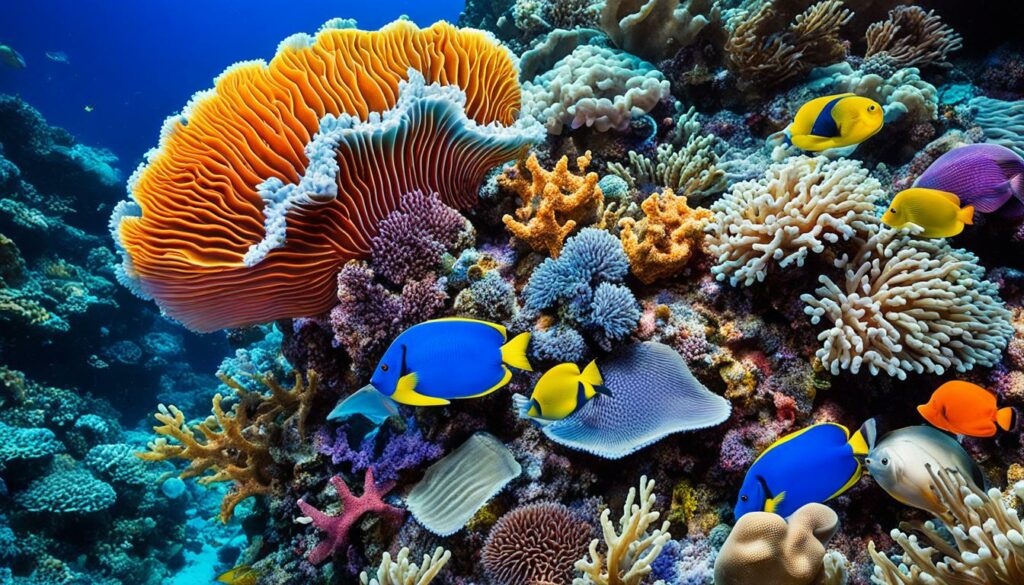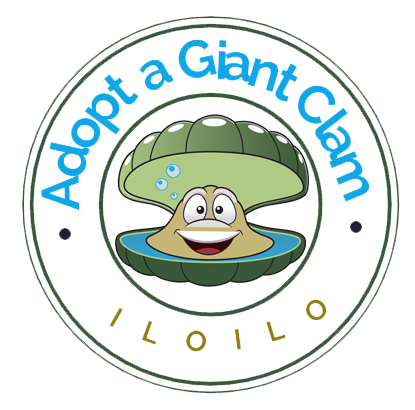Have you ever thought about the amazing creatures living in the Philippines’ waters? The Tridacna gigas, or giant clam, is one of these wonders. It’s crucial to know about its current state and how we can protect it for the future. Join us as we dive into the world of the giant clam and learn about efforts to save it in the Philippines.

Key Takeaways
- Tridacna gigas, the giant clam, is a remarkable marine species found in the Philippines.
- This article explores the importance of preserving the giant clam and the ongoing efforts to protect it.
- We’ll delve into the biology, habitat, and significance of Tridacna gigas within Philippine ecosystems.
- Discover the threats facing the giant clam and the government initiatives, as well as conservation efforts, to ensure its long-term survival.
- Learn how you can contribute to the preservation of this precious resource by adopting responsible tourism practices and supporting local communities.
What is Tridacna Gigas?
The Tridacna gigas, also known as the giant clam, is a fascinating marine species. It is a key part of the Philippines’ rich ecosystems. These clams can grow up to 1.2 meters long and weigh up to 500 kilograms. They are the largest clams in the world.
The Giant Clam’s Biology and Habitat
The Tridacna gigas lives in the shallow, clear waters of the Indo-Pacific region, including the Philippines. They are unique because they live with microscopic algae called zooxanthellae. These algae make food through photosynthesis, and the clams give them a safe place to live.
Significance in Philippine Ecosystems
- The giant clam is vital to the marine ecosystem. It is food for many predators, like fish, sea turtles, and humans.
- They also give home and shelter to many marine animals, like small fish and crustaceans. This helps make the Philippine waters more diverse.
- Also, the Tridacna gigas helps keep coral reefs healthy. It plays a big part in the balance of these underwater worlds.
The giant clam’s big role in the Philippines’ marine life shows how important it is. We need to protect it for the health of our oceans.
Why Preserve Tridacna Gigas?
The giant clam, known as Tridacna gigas, is key to the marine ecosystem in the Philippines. These creatures are vital for the health and variety of life in the waters. They play a big role in keeping the ocean healthy.
Environmental and Ecological Importance
Tridacna gigas acts as a natural filter, cleaning the water. Their size and filtering ability remove lots of particles and pollutants. This helps keep the water clean.
These giant clams also feed many marine animals and provide a home for them. This supports the balance of life in the ocean.
Threats to Tridacna Gigas Populations
Tridacna gigas face threats like overfishing, habitat destruction, and climate change. Overfishing and taking these clams for food and shells has reduced their numbers. Their homes, like coral reefs and seagrass beds, are also being destroyed.
It’s important to save Tridacna gigas for the health of the Philippines’ oceans. By protecting them, we help keep the ocean and all its life thriving. This keeps the balance that supports many different kinds of life in the water.
“The giant clam is a true marvel of nature, and its preservation is essential for the well-being of our marine ecosystems.” – Dr. Maria Gomez, Marine Biologist
Preservation of Tridacna Gigas in the Philippines
The Philippine government is working hard to protect the Tridacna gigas, also known as the giant clam. They have started many initiatives and made rules to keep this amazing species safe. These actions help keep the country’s marine ecosystems in balance.
Government Initiatives and Regulations
The government has set up marine protected areas (MPAs) all over the Philippines. These places are safe spots for Tridacna gigas and other sea creatures. They help the giant clams grow and recover.
The government also has strict laws against taking, trading, and moving giant clams. This stops people from harming them. Plus, they teach local people how to fish in a way that doesn’t hurt the ocean or the giant clams.
Conservation Efforts by Organizations
Many groups in the Philippines are also working to save the Tridacna gigas. They use different ways to help, like teaching, doing research, and working with communities.
- The Coastal Conservation and Education Foundation (CCEF) helps local communities make marine reserves. These places let Tridacna gigas live and have babies safely.
- The Tubbataha Reefs Natural Park is a UNESCO World Heritage Site with a big group of Tridacna gigas. It’s thanks to the park’s hard work in protecting it.
- The World Wildlife Fund (WWF) Philippines is working with the government and others. They promote farming giant clams in a way that doesn’t harm their homes.
Thanks to the Philippine government and conservation groups, saving the Tridacna gigas is a big goal. They want to make sure this special species is around for the future.
How You Can Help Preserve Tridacna Gigas
We all can help save the amazing Tridacna gigas, or giant clam, in the Philippines. By being responsible tourists and supporting local groups, we can help protect this important species.
Responsible Tourism Practices
When you visit the coast in the Philippines, think about how you affect the area. Don’t touch or take Tridacna gigas, as it harms their homes. Just watch them from afar and enjoy their beauty without disturbing them.
- Don’t touch or remove giant clams when you visit.
- Stick to the marine protected areas and follow local rules.
- Learn and share why saving Tridacna gigas is important.
Supporting Local Communities
Working with local groups in the Philippines helps protect Tridacna gigas. Many groups work hard to save these clams and their homes. By joining or helping these efforts, you make a big difference.
- Look for and support eco-tourism that cares for Tridacna gigas.
- Give money or time to groups that protect the giant clam and its home.
- Get your friends and family to visit the Philippines and choose eco-friendly tourism.
By choosing responsible tourism and backing local conservation, we can all help save the Tridacna gigas. This helps protect the beautiful places they live in the Philippines.

“Saving Tridacna gigas is about more than just one species. It’s about keeping the whole marine world safe that depends on it.” – Marine Biologist, Dr. Marisa Reyes
Tridacna Gigas and Sustainable Aquaculture
In recent years, sustainable aquaculture has become a key way to save tridacna gigas, the amazing giant clam, in the Philippines. By raising these creatures in safe places, experts and groups help increase wild populations. They also teach local people why it’s important to protect them.
This method of saving and raising tridacna gigas is very promising for their future in Philippine waters. With careful aquaculture methods, these huge clams can be raised and kept safe. This ensures a steady supply for both helping nature and being sustainable.
One big plus of this new way is how it helps local communities in the Philippines. By getting them involved in raising and protecting tridacna gigas, these communities learn more about these important sea creatures. They understand how these creatures help keep the ocean healthy.
As tridacna gigas face threats like overfishing and damage to their homes, this all-in-one approach to saving and aquaculture gives us hope. By working together, we can make sure the giant clam stays a valued part of the Philippines’ sea life for many years.
“Sustainable aquaculture is not just about growing more seafood – it’s about growing a healthier, more resilient future for our oceans and the communities that depend on them.”
Success Stories in Tridacna Gigas Conservation
The Philippines has seen great success in saving the Tridacna gigas, the giant clam. These stories show how government efforts, community projects, and teamwork between experts and locals work well together. Sharing these stories helps us learn and apply these methods elsewhere to protect this amazing species.
Successful Restoration in Palawan
In Palawan, a team effort between the local government, the Palawan Council for Sustainable Development, and the World Wide Fund for Nature (WWF) has helped bring back Tridacna gigas. They did this by enforcing laws, creating protected areas, and getting the community involved. Thanks to this, the giant clam population has grown a lot in recent years.
Community-Led Conservation in Bantayan Island
On Bantayan Island, the community is leading the way in saving the Tridacna gigas. The Bantayan Island Clam Conservation Project, supported by the local government and NGOs, has taught the community how to protect and grow the giant clam population. This local effort has been very successful, making the community proud of their role in protecting these amazing creatures.
| Location | Key Initiatives | Outcomes |
|---|---|---|
| Palawan | Enforcement of conservation laws Establishment of marine protected areas Community-based monitoring programs | Significant increase in Tridacna gigas population |
| Bantayan Island | Community-led conservation project Monitoring and protection of giant clam stocks Replenishment of Tridacna gigas population | Empowered community and revived Tridacna gigas population |
These stories from the Philippines show how working together, engaging the community, and using smart conservation methods can save the Tridacna gigas. By learning from these examples, we can keep protecting this incredible species for the future.

Future Outlook for Tridacna Gigas Preservation
The future for saving the tridacna gigas, or giant clam, in the Philippines looks hopeful. The government, conservation groups, and local communities are all working hard. They aim to protect this amazing species and keep it safe in Philippine waters.
Research and conservation efforts are key to a bright future. Scientists are learning more about the tridacna gigas. They’re finding the best ways to protect its home, which is vital for its survival. This will help guide conservation plans to meet the species’ needs.
The Philippine government is also playing a big role. They’re making laws and enforcing them to stop illegal taking and trading of tridacna gigas. This could help the giant clam populations grow and flourish again.
But, there are still big challenges ahead. Climate change, pollution, and damage to its home are threats. We need to keep a close eye on these and find ways to lessen their effects on the tridacna gigas. We also need ongoing support and awareness to keep conservation going.
Together, we can make sure the tridacna gigas stays a key part of the Philippines’ marine life. With hard work and new ideas, we can keep this important species safe for the future.
“The preservation of the tridacna gigas is not just about saving a single species, but about safeguarding the delicate balance of our marine ecosystems and ensuring a sustainable future for both the environment and the communities that depend on it.” – Dr. Maria Reyes, marine biologist
Conclusion
Protecting Tridacna gigas, the giant clam, in the Philippines is vital. We need everyone’s help to keep them safe. By understanding their importance and the dangers they face, we can work together to save them and their marine homes.
Filipinos can help by supporting eco-friendly tourism, getting involved in their communities, and using sustainable aquaculture. These efforts can make a big difference for Tridacna gigas. By backing conservation efforts and local groups, you can help protect these giant clams.
Preserving Tridacna gigas in the Philippines is a big challenge, but we can do it if we work together. Let’s keep spreading the word, push for better laws, and encourage others to help protect this important part of our natural world. Together, we can make sure it’s safe for future generations.
FAQ
What is Tridacna Gigas?
Tridacna Gigas, also known as the giant clam, is the largest clam species worldwide. They can grow up to 1.2 meters long and weigh up to 500 kilograms.
Where are Tridacna Gigas found?
These clams live in the shallow, clear waters of the Indo-Pacific region. This includes the Philippines.
What is the significance of Tridacna Gigas in the Philippine ecosystem?
Tridacna Gigas are vital to the Philippines’ marine ecosystem. They are a food source for many predators and provide homes for diverse marine life. They also help clean the water, supporting the health and biodiversity of the area.
What are the threats facing Tridacna Gigas populations?
Overfishing, habitat destruction, and climate change threaten Tridacna Gigas. These threats put their long-term survival in the Philippines at risk.
How is the Philippine government addressing the preservation of Tridacna Gigas?
The Philippine government is protecting Tridacna Gigas with several steps. These include creating marine protected areas, laws against collecting and trading giant clams, and promoting sustainable fishing.
What conservation efforts are being made by organizations in the Philippines?
Conservation groups in the Philippines are working hard to protect Tridacna Gigas. They do this through education, research, and community programs.
How can individuals help preserve Tridacna Gigas?
You can help by practicing responsible tourism in coastal areas. Avoid disturbing giant clams and support local conservation efforts financially or by getting involved in the community.
How can sustainable aquaculture contribute to the conservation of Tridacna Gigas?
Sustainable aquaculture is a key way to save Tridacna Gigas in the Philippines. By raising giant clams in controlled settings, researchers and groups can increase wild populations. They also teach local communities about the importance of protecting these clams.
What are some success stories in Tridacna Gigas conservation in the Philippines?
The Philippines has seen many success stories in saving Tridacna Gigas. These stories show how government efforts, community programs, and teamwork between researchers, groups, and locals can make a difference.
What is the future outlook for the preservation of Tridacna Gigas in the Philippines?
The future for Tridacna Gigas in the Philippines looks hopeful. The government, conservation groups, and local communities are all committed to their protection. But, we need to keep a close watch, do more research, and keep up conservation efforts to face new challenges and ensure these amazing creatures continue to thrive.

